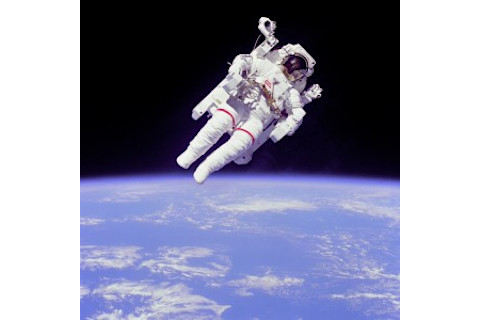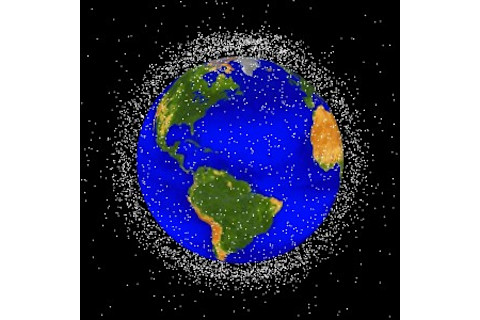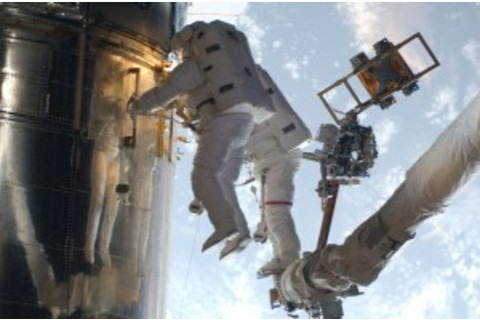3/4/14 update: Gravity got a lot of love at this year’s Oscars, including a best-director award for Alfonso Cuarón and well-earned nods also for cinematography and film editing. Looking back at the movie now, I have two big thoughts. First–no, it cannot happen for real. The space-debris disaster scenario and the orbit-hopping from shuttle to station to station are not physically possible. And second–that artificiality is far less important than the deeper realism of Gravity, which does an exquisite job capturing the beauty and danger of humans tiptoeing off our planet and into the infinite void.
Astronaut Mike Massimino, whom I associate with the George Clooney character in Gravity (see below), clearly agrees. After the Oscars he posted a videocongratulating the cast and crew, and explaining exactly why he thinks the movie is advancing the cause of space exploration. By coincidence, President Obama released NASA’s 2015 budget request a day later. The real-world support for Massimino’s vision of exploration is decidedly mixed. The agency gets funding to keep the International Space Station alive until 2024 and to start work on the exciting WFIRST space telescope, but overall NASA takes a slight pay cut from 2014.
Congress will undoubtedly make some changes. If you would like to have a say in the process, I urge you to contact your Senators and Representative.
Original post: When you take a science geek to a science-fiction film, no good deed goes unpunished. Throw together a bunch of narrative nonsense linked by sheds of technobabble and the boffins will enjoy your movie as high camp (see The Core, Armageddon) or indulge it as well-meaning drama (I’m looking at you, Prometheus). Try to be realistic, like the new movie Gravity, and pretty soon everyone from Neil DeGrasse Tyson to Time magazine (with spoilers galore) is fact-checking you for little slip-ups.

The real deal: Astronaut Bruce McCandless zips around using NASA's Manned Maneuvering Unit, back in 1984. Unlike what you see in Gravity, such suits are no longer in use, and astronauts remain tethered for safety. (Credit: NASA)
NASA
The real deal: Astronaut Bruce McCandless zips around using NASA’s Manned Maneuvering Unit, back in 1984. Unlike what you see in Gravity, such suits are no longer in use, and astronauts remain tethered for safety. (Credit: NASA)
Let me start by saying this: Gravity is intense, riveting, and extraordinarily beautiful. It well deserves its critical and commercial success. If it plays fast and loose with some basic bits of physics–including, ironically, the laws of gravity–it gets a surprising amount right. So it is with affection, and a deep curiosity about space history, that I ask: Could the disaster depicted in Gravity really happen?I addressed that question briefly when I was on Fox News recently. The short answer yes, Gravity gets a lot of the fundamentals right. Space debris is a real problem. If debris compromised the International Space Station and any capsule docked to it, getting back home would be very hard. (OK, not just hard–it would probably be impossible without a rescue mission, but that would be a different movie.) Here I’ll break down the real science and stories behind Gravity, while avoiding spoilers as much as possible.
Clooney and Bullock. I had the good fortune of spending some time with the astronauts of the STS-125 missions during their training sessions in 2008. They are the crew that went up in the space shuttle to repair the Hubble Space Telescope–just like the fictional crew in Gravity. George Clooney’s character, Matt Kowalski, reminded me of the chatty and gregarious Mike Massimino, who has made repeat appearances on Big Bang Theory. Sandra Bullock’s character, Ryan Stone, was evocative of the younger and more reserved Megan McArthur. But: Astronauts spend a lot of time training before a mission. By the time I met Massimino, McArthur, and the rest of the crew they had an easy, deep rapport. The notion that they would still be learning basic biographical details about each other on the mission, as happens in Gravity, is useful for advancing the movie’s narrative, but doesn’t reflect the way real astronauts talk.

And the movie version: The aftermath of a space-debris disaster in Gravity (Credit: Warner Brothers)
Warner Brothers
And the movie version: The aftermath of a space-debris disaster in Gravity (Credit: Warner Brothers)
The equipment. Gravity does a pretty good job showing how difficult it is to do basic things like removing circuit boards or tightening screws in space. The Hubble Space Telescope, space shuttle, and International Space Station are shown with a lot of realism. Astronauts really do rely on tethers when they do space walks, as shown in the movie. Kowalski’s flight suit is patterned on the real Manned Maneuvering Unit (MMU) flown by NASA in 1984. But: The MMU was abandoned by NASA after the Challenger disaster because it was seen as too dangerous. The only flying suit in use today is a little emergency pack called SAFER, which carries just 3 pounds of nitrogen propellant. Contrary to what you see on screen, NASA would not allow untethered flight even with a flight suit. And certainly no self-respecting astronaut would go stunt-flying around delicate equipment, using up all his propellant, as Kowalski does. But hey, it looks really cool on screen.
The movements. On the whole, Gravity does a fantastic job depicting the dreamy, slow-motion world of spaceflight. The scenes of laborious work on the Hubble telescope while the Earth looms overhead–all sense of up and down totally scrambled–are lovely and realistic. When things go wrong, Stone goes into a tumble and can’t stop. That’s the way things go in space–when you start moving you just cannot stop. It evokes a real-life, terrifying accident that happened three months ago when Italian astronaut Luca Parmitano suffered an internal leak in his space suit. His suit started to fill with water, covering his eyes and ears, while he went into a slow tumble. I highly recommend checking out Luca’s blog. But: This one has a MILD SPOILER attached to it. At one key point, Stone tries to hold onto Kowalski but he is pulled away, as if he is dangling over the edge of a cliff. At this point, everything the movie got right about spaceflight goes horribly wrong. Both astronauts are still in floating in microgravity. One tug and Kowalski would come floating right back. Oops.

A partial map of the 500,000 known bits of space debris in low-Earth orbit. (Credit: NASA)
NASA
A partial map of the 500,000 known bits of space debris in low-Earth orbit. (Credit: NASA)
Space junk. If you’ve seen the Gravity trailer, you know that the whole chain of events in the movie starts with a swarm of space debris. Russia shoots down one of its old satellites, creating a hailstorm of orbiting junk that sets of a chain reaction. In fact there is a lot of debris in low-earth orbit: NASA is tracking about 500,000 pieces larger than 1 centimeter (roughly a half-inch) across. At that altitude, objects are orbiting at about 30,000 kph (18,000 mph), fast enough to make a crater. The Space Station is designed to survive a hit by a 10-centimeter (4-inch) chunk, but a hailstorm of debris could easily destroy shuttle and Station alike. Space engineers really do worry about space-junk chain reaction–sometimes called the Kessler Syndrome–and are looking at ways to reduce the amount of debris in low Earth orbit. But: The Russians know all about this and presumably wouldn’t do anything to create such a problem; in fact, they are prohibited from doing so by treaty. Debris in low Earth orbit wouldn’t knock out communications satellites, which circle at much greater altitudes. And MILD SPOILER you wouldn’t see the junk coming. It’s traveling at ten times the speed of a rifle bullet. Think how easy it is to see a rifle bullet coming your way. Uh huh.
Orbital dynamics. The Hubble telescope, Space Station, and another location in the movie (I’ll leave it unnamed) all have quite different orbits. You can’t just hop from one to the next. Neil DeGrasse Tyson was especially annoyed by this one. But I think it falls well within artistic license: It’s a way to dramatize the astronauts’ predicament, and Gravity handles the drama effectively, even if it isn’t realistic.
Astronaut risks. The whole point of Gravity is that life in space is incredibly dangerous and precarious. True enough. But: The greatest risks in space flight are takeoff and landing. Space itself is surprisingly safe in comparison. The statistics tell the story. A total of 18 people have died on space flights, but of those 18 only 3 have lost their lives in space proper: The crew of Soyuz 11, who died on June 30, 1971, when a valve failed and their capsule depressurized. Their deaths helped inspire the Fallen Astronaut memorial sculpture and plaque on the moon. The other 15 died during takeoff or landing. Another 11 died during training (including the 3 who died in the Apollo 1 fire). And far more people have lost their lives on the ground making spaceflight possible. An estimated 350 people have died due to rocket explosions, and 24 more in a variety of spacecraft factory and launchpad accidents.

The fourth and final space mission to repair the Hubble Space Telescope, in 2009, looked very much like the scenes in Gravity. (Credit: NASA)
NASA
The fourth and final space mission to repair the Hubble Space Telescope, in 2009, looked very much like the scenes in Gravity. (Credit: NASA)
The bottom line: So what would really happen to you if you were stranded in space? The standard Space Station suit carries 8 hours of oxygen, plus a 30 minute reserve. If you cannot refill or find a safe haven in that time, CO2 levels build up and you eventually black out. With all that space debris flying around, more likely you would spring a leak in your suit.
If you depressurize, your timetable gets a lot more, er, compressed. Exposed to vacuum, you’ll pass out in about 10-15 seconds (and don’t try to hold your breath–the air pressure will explosively expel the air from your lungs). Animal studies show that monkeys exposed to vacuum for less than 3.5 minutes could be revived with no permanent brain injury. At that point, the animals’ hearts stopped and there was no turning back. One person was exposed to vacuum, during a 1965 ground experiment, and lived to tell the tale–take a look at this amazing video of NASA test subject Jim LeBlanc. Some other hair-raising case studies are here. Unless help were right at hand, the true ending to Gravity would likely be a grim one.
Watching Gravity, I was reminded of another recent sci-fi movie, one that paid even closer attention to the real details of a space mission: The smart, under-appreciated Europa Report. I thought about how incredible it is that so few people have died in space–not a single fatality since 1971. And I kept thinking, again and again, how spectacular the universe looks from orbit.
Gravity may be a disaster movie, but after watching it I was itching to go into space myself.
Follow me on Twitter: @coreyspowell













